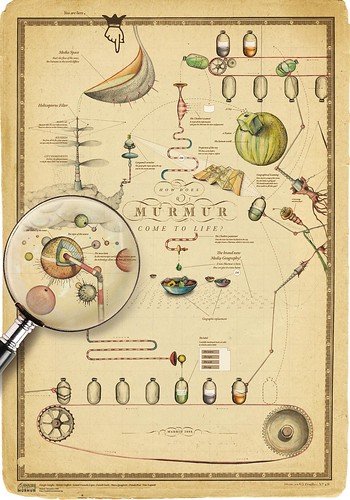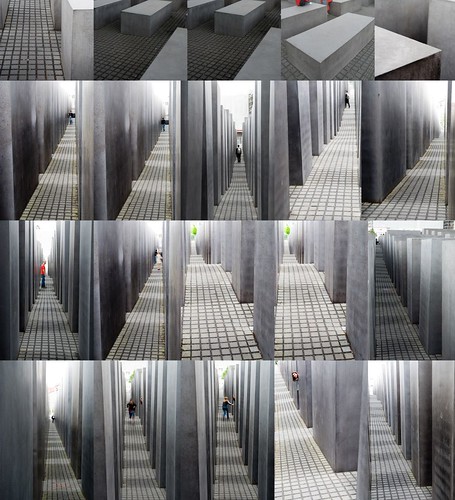We are proud to present our research in the visualization of complex systems at the Arts | Humanities | Complex Networks — a Leonardo satellite symposium at NetSci 2010 taking place at BarabásiLab — Center for Complex Network Research, Northeastern University in Boston, MA, on Monday, May 10, 2010.
Archive for the “Theory” Category
Tell them anything but the truth: they will find their own
Tuesday, February 23rd, 2010DensityDesign for TEDx: ideas worth spreading.
Monday, December 7th, 2009On november 2009 Density Design has been invited to take… more
The image of the city – Visualization of sense
Tuesday, May 19th, 2009My PhD Thesis – Work in progress, year 1/3. Throughout… more
Murmur. Project Progress Report 01
Monday, November 10th, 2008
Murmur, originally uploaded by densitydesign.
After a week of cañas, tapas, fried food and heavy work this is the first result of the Visualizar’08 Workshop.
More specifically this is the wiki page of murmur
Numbers & Statistics, Biases & Emotions
Sunday, October 26th, 200827 August 2008
Michael Bond
http://www.newscientist.com/article/mg19926711.500-how-to-keep-your-head-in-scary-situations.html
This has led Slovic to suggest we need to imbue statistics with more emotional significance so that we take them to heart. “We learn how to deal with numbers from a young age as cold or abstract entities – to read them, add them, multiply them – but we don’t learn to think about how they represent reality in a way that conveys feeling and meaning. We need to think how to teach people to step away from their intuitive response, which is insensitive to magnitude, and think more carefully about what numbers represent.” […]
Changing the change Paper
Friday, September 26th, 2008HANDLING CHANGES THROUGH DIAGRAMS
To change towards a more sustainable development could means to make decisions not only with a systemic approach, but also to be able to decide in the right time: the density. It seems that, when the discipline of Design integrate a systemic approach with the competences of designers in visualization, it can cope with dense situations, providing effective artefacts – diagrams – to improve the decision process and making profit from the richness of complexity.
The inside diagram
Wednesday, September 10th, 2008The traditional monument is understood by its symbolic imagery, by what it represents. It is not understood in time, but in an instant in space; it is seen and understood simultaneously. Even in traditional architectures such as labyrinths and mazes, there is a space-time continuum between experience and knowing; one has a goal to work one’s way in or out.
Experience & Imagination
Wednesday, September 3rd, 2008Knowing Complex Systems. The limits of understanding
Due to their non-linear nature, complex systems are incompressible. They are also open systems and cannot be understood without also understanding their environments and their history. To fully know something complex will therefore involve incorporating all the complexity of the system and its environment. This not humanly possible, perhaps not even possible in principle. Thus, our models of complex systems always have to reduce the complexity. Since what is left out also has non-linear effects, we cannot predict the error made in the reduction. The modelling and understanding of complex system thus always involve an element of choice which cannot be justified by pure calculation. There is always a normative element involved.
DRM
Thursday, July 10th, 2008
DRM, originally uploaded by densitydesign.
DRM research shows how research in design can be an effective tool in producing innovation in many strategic fields in the national system, but in general also for contemporary economies, beyond the common stereotypes which accompany the view of this discipline. This awareness must guide the actors of research and the institutions they must sustain in order to enter a more structured course of actions, most of all integrated at an international level. A DRM platform extended to Europe can certainly be a useful tool in increasing this awareness.
Is predictability equals to amelioration?
Saturday, June 7th, 2008
The suggestion by IXDA forum about basic user interaction design concepts gives us opportunity to make clear an intrinsic paradigm to complexity.
As in, if you can accurately predict what’s going to happen next in a System, it’s because the Action you’re taking is understandable, clear, logical and above all brings ameliorations to the main subject. If you can accurately predict what’s next, It means the System has high ameliorability.
If you can’t accurately predict what’s next, the System has low improvement perspectives.
- Make 5 Sentences about Saying Disagreement
- Payment Agreement Sample Philippines
- Can Landlord Charge for New Tenancy Agreement
- Spirit Airlines Tax Receivable Agreement
- Ancillary Services Agreement
- Download Agreement by Shanko Rasheed
- Facebook User Agreement Photos
- Music Production Contracts Templates
- Do Contractors Do Financing
- Free Trade Agreement Russia
- Stock Purchase Agreement Good or Bad
- Terminating Employee Contract Early
- It Support Agreements
- Iran Nuclear Agreement Terms
- Rental Lease Agreement for Ct
- Tcode for Display Contract Status
- Contracts Manager Jobs in Bangalore
- Behavioral Health Contractors Association
- User Agreement in Arabic
- Rcuh Agreement for Services



